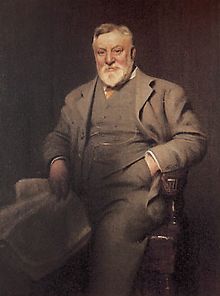 Arthur Lasenby Liberty was a man of taste. What’s more, he had a passion for fabrics and a flair for retail.
Arthur Lasenby Liberty was a man of taste. What’s more, he had a passion for fabrics and a flair for retail.
He came to London from his home town of Chesham, Buckinghamshire, at the age of sixteen to work for an uncle in the wine trade; moved on to a draper’s shop; and finally found his niche with a position at Farmer & Rogers Great Shawl and Cloak Emporium in Regent Street. They don’t name shops like that anymore. ‘Gap’ and ‘Primark’ don’t have the same ring.
In common with those modern retailers, Farmer and Rogers imported mostly from India and China; but, taking advantage of the craze for all things Japanese, they opened an ‘Oriental Warehouse’ next door to their main premises in 1862. Two years later, the talented and ambitious Arthur, still only 21 years old, became manager.
The Oriental Warehouse was a great success and it must have been obvious that Arthur was a natural entrepreneur; but coming as he did from a family in straightened circumstances, he lacked the capital to set up on his own. Then in 1874 he became engaged to Emma Louise Blackmore and her father provided the necessary finance; in fact, the money provided by his new father-in-law only stretched to half a shop, which Arthur called East India House.
It was not until 1924 that Liberty moved to the iconic half-timbered building where it is still housed.
But back to East India House in the 1870s: Arthur’s new shop was a magnet for all the louche, artistic types that defined the taste of the time – Rosetti, Burne-Jones and of course the not-so-louche William Morris: they all hung out there. Although he began by selling only plain dyed silks, Arthur soon began to work with a printer in Staffordshire to develop a range of colour fast dyes in the subtle, pleasing colours found in oriental rugs and fabrics and used them to produce hand-blocked prints; his range of ‘Liberty Art Fabrics’ was born.
Arthur’s early prints were on silk and included the paisleys that are still associated with the Liberty name today. Tana lawn, the super-fine, soft cotton with a silk-like feel that I use for most of my shirts, was introduced in the 1920s,and named after Lake Tana in Ethiopia, where the cotton used to produce it originated; at around the same time, the classic small floral ‘Liberty prints’ began to be produced.
Liberty was associated with all the best design movements and was a byword for the arts & crafts, aesthetic and art nouveau movements. Peacock feathers were a much-used motif in the aesthetic movement and in 1887, this design ‘Peacock Feather’ was produced for Liberty by Arthur Silver of Silver Studio and printed in Rossendale. It was later renamed ‘Hera’.
All Liberty designs are archived and vintage designs are often the inspiration for new ones. ‘Hera’ was revived in the 1970s and is still in production, still printed in Lancashire today.
Here it is adapted for one of Liberty’s famous silk scarves:
And here it is as a western shirt – or two! Find them for sale at https://www.etsy.com/uk/shop/dandyandrose




